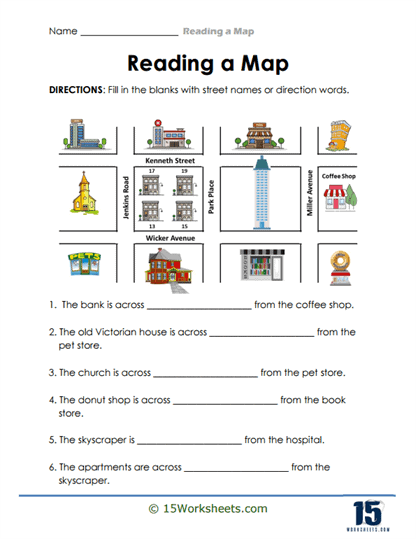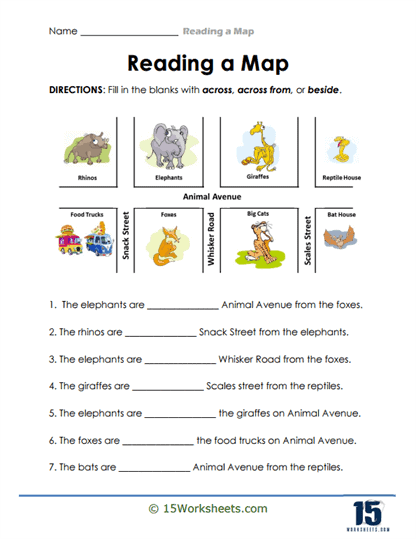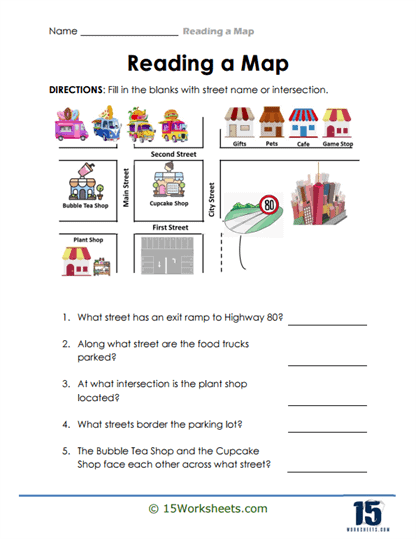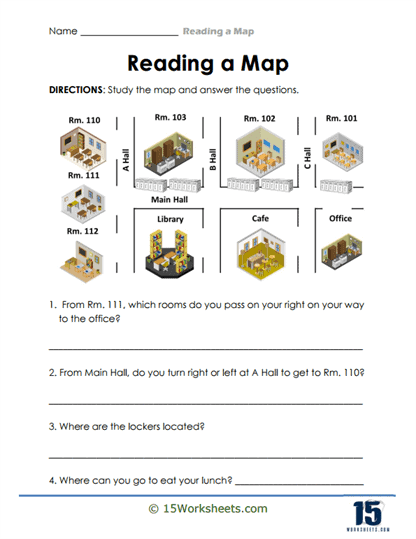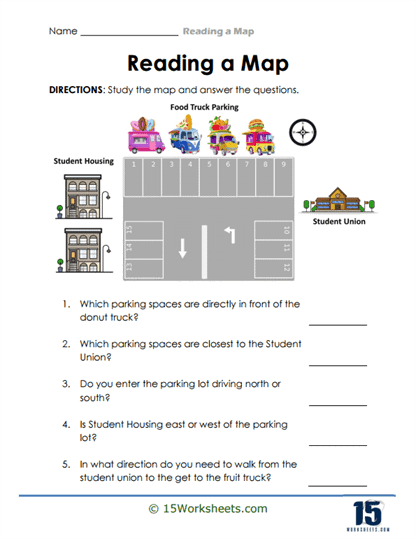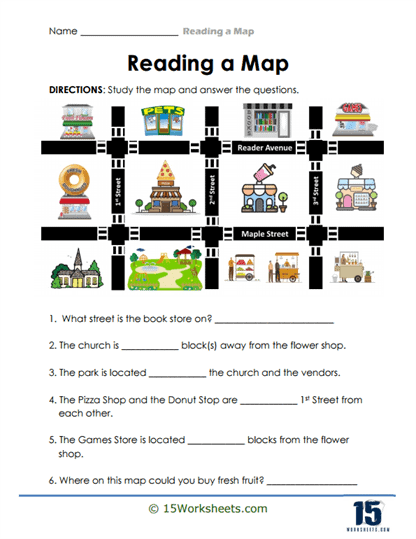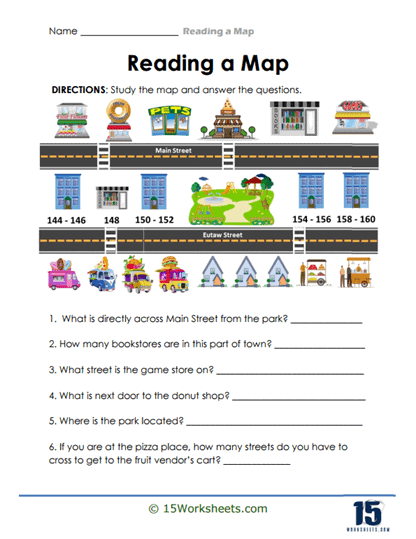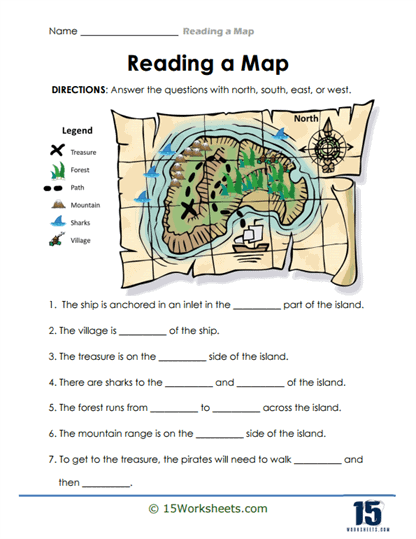Reading a Map Worksheets
All About These 15 Worksheets
These types of worksheets will teach students how to interpret and navigate through various types of maps. These worksheets offer exercises that help students grasp essential map-reading skills, such as understanding symbols, directions, landmarks, and geographic relationships. They often focus on spatial awareness, a key aspect of geography education. Through a combination of visual aids and contextual questions, these worksheets build students’ ability to extract useful information from a map, which is an important skill in both academic contexts and real-world navigation.
The worksheets you have shared represent a variety of exercises designed to engage students in different aspects of map reading. From these examples, we can observe several different types of exercises that are typically included in such a collection:
Identifying Landmarks and Symbols – A common exercise involves using a map legend to identify various landmarks and symbols on the map. For instance, one worksheet asks students to count benches, swings, and picnic tables in a park, forcing them to interpret the symbols representing these items. This practice helps students learn how to use map legends and connect abstract symbols with real-world objects. Additionally, it reinforces the importance of understanding how symbols can vary across different types of maps, sharpening their ability to generalize this skill to new contexts.
Spatial Relationships and Directions – Some worksheets focus on spatial relationships by asking students to describe the relative positions of landmarks. For example, students may be tasked with determining what is directly across from a specific location, or which landmark is north, south, east, or west of another point on the map. One worksheet, for instance, asks students to write direction words (north, south, east, west) based on the positions of landmarks around Lake Champion. Such tasks teach cardinal directions and improve spatial reasoning. Over time, these exercises also encourage students to visualize geographic layouts in their minds, aiding memory retention and mental mapping.
Reading Street Maps and Intersections – Several worksheets present more complex street maps, where students are asked to analyze urban layouts. One example shows a map with streets and various buildings (e.g., a pizza shop, hospital, hotels), and students must determine which streets need to be crossed to get from one building to another. These types of exercises promote practical map-reading skills that could be used in everyday life, such as navigating city streets or understanding how roads and landmarks are laid out in relation to each other. This is especially useful for developing independence, as students learn to plan routes and identify efficient pathways through urban and suburban environments.
Comparative Distance and Proximity – In another type of exercise, students are asked to compare distances between locations. For example, one worksheet may ask which hotel is closer to a pizza shop or a campground. These types of questions encourage students to pay close attention to proximity on the map and develop an understanding of relative distance, which is an essential skill for effective navigation. Mastering this skill can also improve their ability to estimate travel times or distances in real-world scenarios, a key aspect of both daily planning and travel preparation.
Crossing Paths and Barriers – Many exercises include tasks where students must navigate barriers such as rivers, roads, or channels. For instance, one worksheet involves a river with a bridge, and students must determine which town must be passed through to cross the South Channel. These types of questions help students comprehend physical boundaries on maps and how different features are connected through infrastructure like bridges or highways. Such exercises also build problem-solving skills, as students must think about alternative routes or solutions if a particular path is blocked by a natural or man-made barrier.
Land Use and Zoning – Some worksheets focus on the layout of towns or regions, illustrating various zones like residential, commercial, or recreational areas. Students might be asked to identify where parks, shops, or residential buildings are located on the map. This helps build an understanding of how communities are organized geographically and the purpose of different areas. Beyond map-reading, these tasks introduce concepts related to urban planning and how different land uses coexist to support a functioning community, encouraging students to think about their surroundings in a broader social context.
Matching Landmarks and Directions – Another exercise type includes questions that ask students to fill in blanks with street names or direction words based on their understanding of a map. For instance, one worksheet asks students to figure out which landmarks are “across from” or “next to” others by completing sentences with the correct location names. This promotes a detailed analysis of the map and reinforces the ability to match descriptive language with visual layouts. Over time, it sharpens their vocabulary and ability to articulate spatial relationships clearly and concisely, an essential communication skill.
Coloring Maps Based on Features – Some worksheets take a more interactive approach by asking students to color different areas of the map according to their features, such as forests, lakes, or mountains. This combines the fun of coloring with a deeper understanding of topographical and environmental features. By associating specific colors with certain types of land, students gain a better understanding of how to visually categorize different parts of a map. This artistic engagement can also reinforce learning by making abstract geographic concepts more tangible and memorable through hands-on activities.
Analyzing Traffic and Road Systems – A few of the worksheets focus on analyzing transportation systems, such as which streets lead to an exit ramp or how food trucks are parked in relation to other landmarks. In these exercises, students learn how to interpret traffic patterns, parking lots, and road intersections. This kind of exercise enhances practical navigation skills, such as finding parking or understanding highway exits. Additionally, it prepares them for the complexity of real-world road systems, teaching how to anticipate traffic flow and navigate busy areas like parking lots or food truck parks.
Real-Life Navigation Scenarios – A common theme across these worksheets is their emphasis on real-life scenarios, such as navigating a park, a city block, or a neighborhood. Students might be asked to imagine how they would travel from a bookstore to an apartment building or from a pizza place to a fruit vendor’s cart. These types of exercises bridge the gap between theoretical map reading and practical use, preparing students for real-world navigation challenges. Furthermore, it fosters independence, equipping students with the skills to plan trips or errands and navigate unfamiliar areas confidently and efficiently.
Common Elements Found on Maps
Title – The title of a map is crucial because it tells you exactly what the map is about and what information it will provide. It’s usually located at the top or in a prominent position on the map and is often in large, bold letters to grab attention. The title can describe a variety of things, like a specific location (such as “Map of the United States”) or a particular theme (like “Weather Patterns of North America”). Without a clear title, it would be difficult to understand the purpose of the map or what area or topic it covers, which could lead to confusion. The title sets the context and helps you know what to look for before you even begin reading the map.
Legend (Key) – The legend, sometimes called the key, is like a decoding tool that helps you understand the symbols, colors, and lines used on a map. Maps use many symbols to represent things like highways, rivers, forests, and airports, and the legend explains what each symbol means. Without a legend, the map’s symbols would be meaningless, leaving you guessing what different features represent. For instance, a green area might show a forest, while a red star might represent a capital city. The legend makes it easier to interpret the map and ensures that no matter how many symbols are used, you can always understand their meaning.
Compass Rose – A compass rose is a figure on the map that shows the four cardinal directions: North, South, East, and West, and sometimes includes intermediate directions like Northeast and Southwest. It helps you orient the map to the real world so you can know which way you’re facing or traveling. For example, if you’re using a map to navigate, and you see that a mountain is located to the east, you can align the compass rose with your real-world direction to figure out where the mountain is in relation to you. The compass rose ensures that you don’t get lost while using the map and can follow routes correctly. Without it, understanding the layout of places or planning a journey would be much harder.
Scale – The scale of a map shows the relationship between distances on the map and actual distances in the real world. A scale could be something like “1 inch equals 10 miles,” which means if two cities are 1 inch apart on the map, they are actually 10 miles apart in real life. The scale allows you to calculate distances accurately and plan how far you may need to travel. Different maps have different scales—some maps cover large areas and have smaller scales, while others focus on small areas with larger scales. Without a scale, you wouldn’t know if the features on the map are close together or far apart, making it harder to navigate.
Grid – A grid on a map is made up of lines that create squares or rectangles, often labeled with letters and numbers along the sides. This system helps you find specific locations by using coordinates, such as “C5,” which refers to the area where column C and row 5 intersect. Grids are especially useful on larger maps or atlases, where it might be hard to pinpoint a specific city, road, or landmark without some guidance. By referring to the grid, you can quickly locate places without having to scan the entire map. The grid system makes reading maps more organized and ensures that even detailed maps are easy to navigate.
Symbols – Symbols on a map are small icons or drawings that represent real-life features, such as mountains, airports, forests, or hospitals. They simplify the map by allowing it to convey a lot of information without using too many words or cluttering the map with text. These symbols can vary depending on the type of map; for example, a weather map might use symbols for clouds, rain, and snow, while a road map uses lines and shapes for highways and intersections. Without symbols, maps would be far less efficient, requiring long descriptions that could make them difficult to read. The use of symbols makes maps quicker to understand and more user-friendly.
Labels – Labels are the names or words on a map that identify specific places, such as cities, rivers, mountains, or countries. They provide crucial information about what the different parts of the map are called, and are often placed near the features they describe, like a label for a river written along the river’s path. Sometimes, labels are bold or large to highlight important locations, such as a capital city or a major landmark, while less significant places may have smaller labels. Labels not only help you know the names of places but also give clues about their importance or size based on how they are presented. Without labels, maps would be almost impossible to use because you wouldn’t know what anything is called.
Latitude and Longitude – Latitude and longitude are a global system of lines that help you pinpoint any location on Earth with accuracy. Latitude lines run horizontally around the Earth, while longitude lines run vertically, creating a grid that assigns coordinates to every place. By using these coordinates, like 40°N (latitude) and 74°W (longitude), you can find an exact spot anywhere in the world. These lines are especially useful for global navigation and are commonly used in GPS systems to provide precise directions. Latitude and longitude are essential for understanding global maps, especially when dealing with large-scale geographic areas where traditional grids won’t work.








